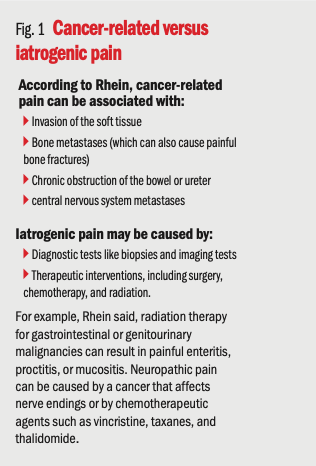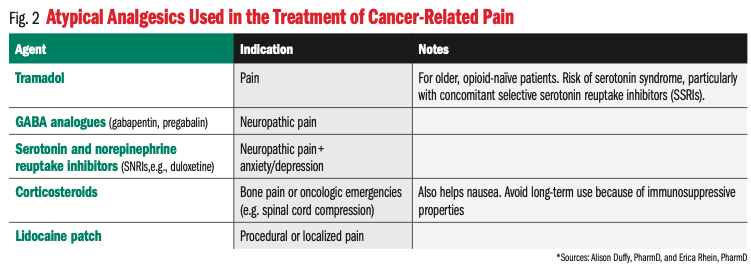Conquering Cancer Pain
Special consideration for pain management in patients with cancer.

Cancer-related versus iatrogenic pain

Atypical Analgesics Used in the Treatment of Cancer-Related Pain

Pain is a very common and dreaded symptom in oncology patients, reportedly occurring in more than half of patients with active cancer and one-third of cancer survivors.
“Unrelieved pain impacts patients’ quality of life and comfort,” said Alison Duffy, PharmD, oncology clinical specialist at the University of Maryland Medical Center and associate professor in the department of pharmacy practice and science at the University of Maryland School of Pharmacy in Baltimore. “Ultimately, their survival outcomes are definitely linked to early and effective palliative care, which includes pain management,” she said.
Pain Causes
Erica Rhein, PharmD, clinical pharmacist at UCHealth Anschutz Cancer Pavilion’s outpatient palliative care and oncology urgent care clinics and assistant professor at the University of Colorado Skaggs School of Pharmacy and Pharmaceutical Sciences categorizes pain as directly cancer-related or iatrogenic (Fig. 1).
Determining the source of the pain can be tricky and involves listening closely to the patient and using imaging studies when appropriate. Duffy recommends PQRST pain assessment (questioning the patient about Provoking factors, Quality, Region/Radiation, Severity, and Time). The patient’s description of the pain can provide important clues, Rhein said. “Neuropathic pain tends to be hard for patients to localize and has descriptors like burning and shooting,” she explained, “while somatic pain is a lot of times easier for a patient to pinpoint.” There are often multiple sources for the pain requiring treatment with multiple modalities.
Analgesic Options
In this patient population, the usual go-to non-opioid options are fraught with complications.
Although nonsteroidal anti-inflammatory drugs (NSAIDs) should theoretically be ideal, since cancer-related pain frequently has an inflammatory component, they have many potential contraindications, said Rhein. NSAID use is problematic in patients with renal dysfunction due to their cancer (for example, multiple myeloma) or advanced age, Duffy added. In patients undergoing active treatment, Rhein said, NSAIDs can interact with chemotherapeutic agents by increasing cumulative renal toxicity or by decreasing renal clearance of the chemotherapeutic agent so its toxicities are increased. Additionally, the increased risk of bleeding associated with NSAIDs is problematic for patients whose cancer increases bleeding risk (eg, gastrointestinal cancers) or who have chemotherapy-related thrombocytopenia, Rhein added.
Acetaminophen also has its concerns. Its dose is limited in patients with liver impairment due to cancer location, liver metastases, or chemotherapy, Duffy said. It can only be used sparingly in neutropenic patients with hematologic malignancies since acetaminophen can mask fevers. If pain requirements are high, she said she prefers to use another agent. Even when acetaminophen is a safe option, it often is not enough for effective pain relief, Rhein said, so it is often used in conjunction with opioids as an opioid-sparing agent.
Opioids as the Backbone of Treatment
Rhein and Duffy agree that in oncology patients, opioids are often the best and safest option.
The most commonly used opioids in oncology patients are morphine, oxycodone, and hydromorphone. For patients with liver dysfunction, Duffy said, morphine is preferred over oxycodone, and vice versa for patients with kidney dysfunction.
Opioid choice, however, is often dictated by cost and insurance formularies.
“Once patients are getting higher doses of opioids, even medications like morphine that are considered to be more affordable can become very expensive, so the cost is definitely something that we have to consider for our patients,” Rhein noted.
Before patients are started on opioids, they must be screened for risk factors for opioid misuse and addiction. All the information in the media about the opioid epidemic has made some patients wary of taking opioids, Rhein said, and these patients must be educated. “There are certainly patients that have their pain sub-optimally managed because of their concerns about addiction, and some of those challenges are based on the hyperawareness in this country,” Duffy said. Oncology patients with a history of substance use disorder can be very challenging to manage, Rhein said.
This is particularly for opioid naïve patients, who are then usually started at low doses of opioids, said Duffy. Patients with chronic or advanced cancer pain may require long-acting opioids such as extended-release morphine (MS Contin) or oxycodone (OxyContin). Fentanyl patches are also an option, according to Duffy, particularly for patients who have compliance issues or have swallowing difficulties due to head and neck or gastrointestinal cancers.
Rhein reported that she also uses methadone quite a bit in her clinical practice, as it has benefits for both neuropathic and somatic pain and is often better tolerated than very high doses of the opioids. Patients must usually be hospitalized during methadone up-titration, and Duffy cautions that clinicians must be on the lookout for QTC prolongation, particularly in patients taking other drugs that affect the QTC interval.
Counseling Points for Patients with Cancer
When counseling patients being treated for cancer pain, particularly with opioids, pharmacists should realize that these patients are often legitimately taking other sedating drugs such as benzodiazepines, Duffy said. These patients must be screened for falling risk and cautioned about the risks of driving while sedated.
Many patients on high doses of opioids also have multiple risk factors for constipation, such as chemotherapy, radiation, and hypercalcemia due to bone metastases. Since constipation increases risk for bowel obstructions, she said, pharmacists should counsel these patients about constipation and ensure that they are on appropriate bowel regimens.
For patients on more than 1 opioid, Duffy said, “make sure they understand the maintenance basal rate of their long-acting control and the bolus nature of the short-acting one.”
Clinicians should understand that drug therapy alone may not be adequate for pain management.
“There is a huge psychosocial component of the pain experienced in patients with cancer, and you often have to address that to have any hope of controlling the pain,” Rhein said.

Navigating Ethical, Financial Considerations When Delivering Cancer Care
April 30th 2024“I think in those situations where you can use the lower cost of the drug, you should, because it's going to help the overall societal perspective. That begins to break down, though, when that low-cost drug is the one that you're losing money on,” said Scott Soefje in a Q&A on balancing cost and margin at a site of care.